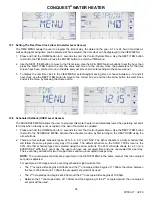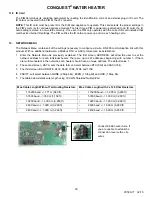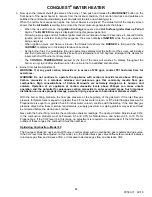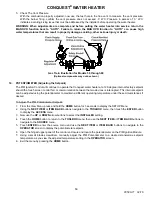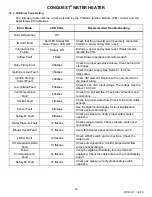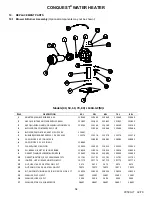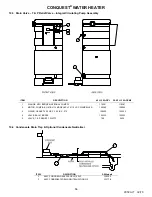
CONQUEST
®
WATER HEATER
44
PV500-71 02/16
6. Ignition
- When dwell time is completed a 4-second Trial for Ignition (TFI) period is initiated:
a. The Gas Safety Valves are energized.
b. The hot surface element is de-energized during the last second of the TFI period.
c. During TFI the flame safeguard control will monitor the flame using flame rectification through the hot
surface igniter.
d. If the flame control senses the presence of flame before the end of the TFI period, the igniter will be de-
energized and the flame control will continue to monitor the flame, through the igniter, until the operating
thermostat ends the call for heat condition.
7. Heating
a. The flame status, airflow switch, LWCO switch, water pressure switch and other safety switches are
continually monitored for proper state.
b. The High Limit sensor is confirmed to read below the High Limit setpoint.
c. The temperature of water in the tank is compared to the temperature control set point to determine when to
begin firing in heating mode.
d. The water heater remains in heating mode and, with extended operation, condensation begins to fill the
condensation trap and drain line; (a normally operating booster heater does not create condensation). The
water heater stops firing when the tank water temperature matches the temperature control set point.
e. The gas valve(s) are immediately disabled.
f. A Blower Post-purge is completed and the control proceeds to Standby mode.
8. Integral
Circulating
Pump –
The circulating pump is controlled independently of the call-for-heat.
a. When the main control switch is turned on, the control system will continuously monitor the water
temperature in the tank and attempt to maintain a uniform water temperature within the tank by using the
integral circulating pump.
b. If the temperature sensed in the tank drops 5 degrees or more below the temperature setpoint, the pump is
energized and a pump circulator icon will illuminate on the control display touch screen.
c. The operation of the integral circulating pump may occur before, during or after the call-for-heat period.
9. Flame Failure / Flame Loss
a. If the igniter fails to sense flame during an attempt to light the burner (Ignition Trail Fail), the ignition control
will end the ignition sequence and the gas valve will be closed. Immediately following the end of the first
failed ignition cycle, a new ignition sequence will be initiated to attempt to relight the burner. The standard
configuration of the Conquest water heater allows for three ignition failures before lockout. If the Conquest
includes the CSD-1 option, this ignition failure will result in a lockout and require manual reset to attempt
operation again
b. If the burner successfully lights and operates but the flame is lost, the gas valve will be closed and the
blower will continue to operate in order to purge any remaining combustion products from the water heater.
If the Conquest includes the CSD-1 option, this flame loss will result in a lockout and require manual reset
to attempt operation again. The standard configuration of the Conquest water heater allows for three (Main
Flame Loss) occurrences before lockout. Following each (Main Flame Loss) the PIM will purge and initiate
the ignition sequence until the maximum of three flame loss events occur.





